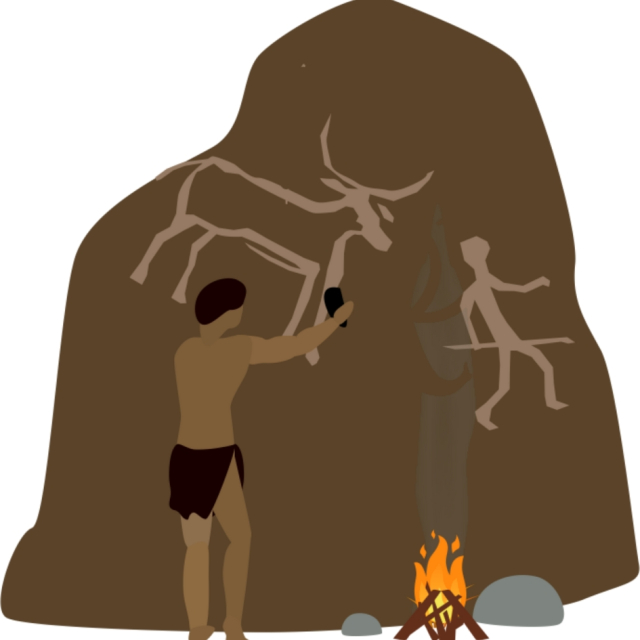Cavemen, a representation of early prehistoric humans, have captured the collective imagination as cave-dwelling ancestors who lived in a primitive world. Although the term "caveman" is more of a cultural interpretation than a scientific term, it refers to early Homo sapiens and their predecessors, such as Neanderthals and Homo erectus, who used caves as temporary or permanent shelters. In this article, we will explore their life, tools, culture, and how they have been represented over time, based on scientific research and archaeological discoveries.
Who were the cavemen?
The term "caveman" is not limited to a specific human species, but encompasses several stages of human evolution. Among the most representative groups are:
- Homo habilis : They lived approximately 2.4 to 1.4 million years ago and were the first to use stone tools.
- Homo erectus : They existed between 1.9 million and 110,000 years ago, and were the first to control fire.
- Neanderthals (Homo neanderthalensis) : They inhabited Europe and parts of Asia about 400,000 to 40,000 years ago and coexisted with the first Homo sapiens.
- Homo sapiens : Our direct ancestors who began to display complex behaviors around 300,000 years ago.
Although it is believed that caves were not their only home, many groups used these natural spaces as shelters, especially in cold climates or during times of danger.
Sources:
The lifestyle of cavemen.
Cavemen's life was deeply connected to their natural environment and their basic survival needs.
Feeding.
They were primarily hunter-gatherers, depending on the resources available in their immediate environment.
- Hunting : They used spears, stones and, later, bows and arrows to hunt animals such as mammoths, deer and horses.
- Gathering : They supplemented their diet with fruits, roots, leaves and nuts.
- Fire : Control of fire marked an important milestone, allowing them to cook food, keep warm, and ward off predators.
Shelter.
Although caves were a popular choice, they also built shelters out of branches, animal skins, and other natural materials. Caves offered advantages such as protection from extreme weather and predators.
Tools.
Stone and bone tools were essential for their survival. These tools evolved from simple stone flakes to more sophisticated tools such as bone knives and needles.
Sources:
Culture and art.
Contrary to the perception that cavemen were simple and primitive, recent studies suggest that they had a rich and developed cultural life.
Rock art.
Cave paintings found in caves such as Altamira (Spain) and Lascaux (France) are impressive examples of caveman art. Dating back more than 30,000 years, these paintings depict animals, human figures and abstract patterns.
Rituals and beliefs.
There is evidence that they practiced funerary rituals, suggesting that they had some concept of spirituality or belief in an afterlife. Neanderthals, for example, buried their dead with tools and flowers.
Music and expression.
Primitive flutes made from bones have been discovered, indicating that cavemen also had an inclination toward music and artistic expression.
Sources:
Evolution and survival.
Cavemen faced multiple challenges that shaped their evolution and development.
Adaptation to climate.
During ice ages, cavemen had to develop strategies to survive in extremely cold climates, such as using animal skins for clothing and building more solid shelters.
Competition and collaboration.
The interaction between different human species, such as Neanderthals and Homo sapiens, was complex. There is evidence of competition, but also of cultural and genetic exchange, as modern Homo sapiens have traces of Neanderthal DNA.
Extinction.
The extinction of groups such as the Neanderthals is attributed to factors such as climate change, competition with Homo sapiens and low genetic diversity.
Sources:
Cultural representation of cavemen.
Cavemen have long been an object of fascination in popular culture, although many depictions are far from accurate.
- Film and Television : Movies like The Croods and characters like The Flintstones present comedic and romantic versions of prehistoric life.
- Literature : Works such as Jean M. Auel's The Clan of the Cave Bear attempt to offer a more realistic perspective on the life of cavemen.
- Museums and exhibits : Museums such as the Natural History Museum in London and the National Museum of Anthropology in Mexico feature exhibits about the lives of early humans based on scientific research.
Sources:
Myths and realities.
It is important to debunk some misconceptions about cavemen.
- They didn't always live in caves : Caves were just one of the options for shelter. Many groups built their own habitats.
- They weren't "brutes" : Research shows they had advanced cognitive abilities and complex behaviors.
- Coexistence between species : Homo sapiens, Neanderthals and other groups coexisted for thousands of years, sharing territories and technologies.
Sources:
Cavemen, far from being simply "primitive men," were pioneers of humanity whose adaptations and achievements laid the foundation for modern civilizations. Through their art, tools, and social behavior, they demonstrated a remarkable ability to adapt and thrive in harsh environments.
Archaeology and science continue to reveal fascinating details about their lives, challenging simplistic perceptions and offering a deeper understanding of our ancestors. Learning about cavemen not only connects us to our past, but also helps us appreciate the resilience and creativity that characterize humanity.
Sources consulted :
